The artist and the rock
April 19, 2012
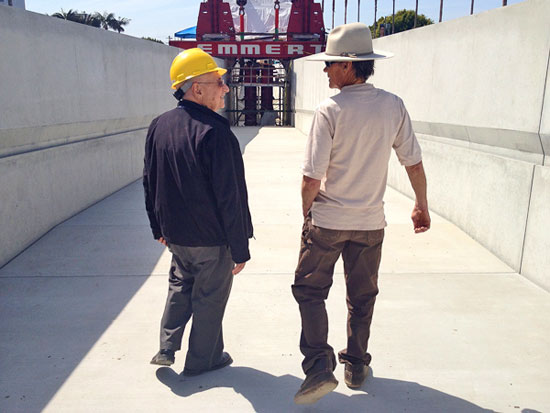
Michael Heizer, right, gives architect Frank Gehry a sneak peek at “Levitated Mass,” which the artist has been quietly assembling at LACMA. Photo/Michael Govan
When we last left The Rock, it was rolling into the Los Angeles County Museum of Art at the end of an internationally televised odyssey. This week, behind cloaked chain-link fences, the two-story-high boulder crossed a much less public milestone: Under the direction of Nevada earth artist Michael Heizer, it was lowered, inch by inch, onto a long concrete trench behind the museum, taking its place in “Levitated Mass,” Heizer’s new masterpiece.
The roar that accompanied Tuesday’s “touchdown,” as crewmembers called it, was not of applause but of heavy equipment. As LACMA Director Michael Govan watched from the sidelines, dust gathering on his dark blue dress suit, the 67-year-old Heizer issued orders from inside the trench, squinting behind sunglasses in a yellow hardhat. Overhead, the boulder dangled from a massive red gantry crane.
“Whoa, whoa, whoa!” the crew cautioned as the 340-ton boulder met the 456-foot-long slot and settled into position. A layer of high-density grout squeezed out across the steel plates that secure the rock to its cradle. Finally—after a flurry of testing, adjusting and grout-scraping—the artist, renowned for precision, relaxed slightly.
“It landed perfect,” he declared to Govan, observing that the rock hit the grout “exactly as it was intended.” Then, not missing a beat, Heizer turned to one of the seven engineers on the project to discuss the myriad ways in which the sculpture is being seismically secured.
The artwork’s assembly this week offered a rare glimpse of the famously publicity-averse artist with the creation that generated a Southern California spectacle earlier this year. For 11 nights in February and March, the granite boulder was a local celebrity as it moved 105 miles on surface streets from a Jurupa Valley quarry to the backyard at LACMA.
While Southern California cheered, partied, made marriage proposals and otherwise marveled at the raw material for Heizer’s project, the artist himself kept his distance—no TV interviews, no press calls, not even a cameo appearance at the boulder’s March 10 grand entrance at LACMA.
Late last month, however, Heizer quietly arrived from his remote compound in the Nevada desert, where he has been working for the past four decades on “City,” a vast, Stonehenge-scaled project near Area 51, the secret military installation.
Since then, he’s been living with his wife and dog in an Airstream trailer on the LACMA campus, just a stone’s throw from his artwork, which will allow visitors to walk down the trench and under the boulder, positioned 15 feet overhead. Heizer’s expected to return to Nevada later this week
On Monday, as TV crews arrived to witness the artwork’s progress at LACMA’s invitation, Heizer remained in the Airstream. But on Tuesday, with the media gone, the artist emerged up close and personal with his creation, fine-tuning its support system, measuring its angles, even lying down flat on the bare earth to peer into its crevices to make sure no telltale signs of connection were showing.
“You’ve got to get this dug out,” he called to one worker, pointing to a smudge of grout along the rock’s edge. “Can we get a piece of plywood?” he called to another. “If I had something that was taking a load here, it would be better,” he instructed an engineer, studying the rock’s corner. “If you can make that load-bearing, I think that’s the 3,500-year plan that we’re looking for.”
Between conferences, Heizer chatted with Govan about Keith Heyer Meldahl’s “Rough Hewn Land,” a book on the geology of the West that Govan had given to the artist. (Among other things, the book argues that, when it comes to the Big One, the San Andreas fault is far less dangerous than the faults near Salt Lake City.)
Mostly, however, the artist was all business. As for Govan, his reaction to the rock’s successful placement was “incredible relief.”
“There was so much discussion of the stress up to this point,” said the museum director. “Would it land correctly? They had been shaving the bottom of the rock, they’d been talking about the grout. Then, as Mike said, it pretty much landed perfectly, just as he’d planned—but after a month of intense discussion.”
Seismic engineering will continue this week as the rock is permanently affixed to the steel shelves. Besides the high-density grout, the rock is being drilled with nine holes that will be injected with high-strength epoxy, followed by the insertion of 1-inch diameter pins that will keep it from lifting or rolling in an earthquake. Then five steel “wedges” will be placed around the rock to prevent side-to-side sliding.
After that, Govan says, “the rest is cosmetics,” as a desert-scape is installed around the sculpture. The museum director hopes to open “Levitated Mass” to the public in mid-June.
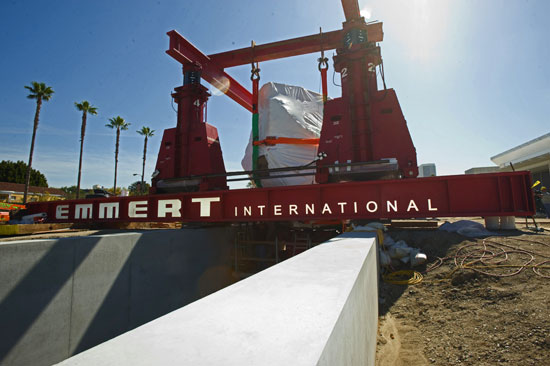
This week at LACMA, the rock finally was attached to a concrete channel to form "Levitated Mass," which the museum hopes to open in June.
Posted 4/19/12
L.A. Earth Day times four
April 19, 2012
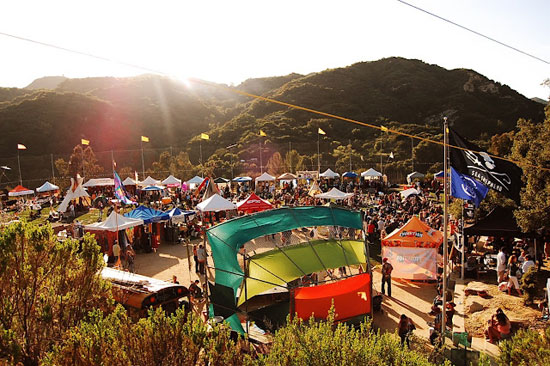
Maybe this is the year to experience Earth Day, Topanga-style. The 2011 festivities are shown above.
Sure, you could slap a “Love Your Mother” bumper sticker on your car and call it an Earth Day, but why stop there, when there are so many hands-on ways to mark the occasion?
Whether you fancy yourself an artist, activist, environmentalist or any combination thereof, there’s probably something to suit you in Los Angeles County this Earth Day, Sunday, April 22.
Here are four very different ways to nourish the planet—and the soul:
Heal the Bay
Stewardship will be rewarded during Heal the Bay’s Earth Day festivities. Those who participate in a “Nothin’ but Sand Beach Cleanup” (Option 1 | Option 2 | Option 3) will get free admission to a weekend of festivities at the Santa Monica Pier Aquarium (Day 1 | Day 2). If none of those fit your schedule, you could always make your way out later in the month for the Great L.A. River Cleanup.
LACMA
Earth Day at LACMA: Because Earth without Art is Just “Eh” compiles a heap of Earth-friendly activities with an artistic angle. Visitors can tour gardens and landscape installations, create art from recycled materials, watch films on the benefits of bike culture, and more.
L.A. Works
Service-oriented earthlings might consider joining the folks at L.A. Works for a week of environmentally friendly volunteer opportunities. Build gardens for local schools, or, at the end of the week, participate in Community Day, which commemorates the 20th anniversary of the 1992 Los Angeles riots by building a community garden on a vacant lot where a corner store was burned. The garden will be used to teach local youth about healthy food and will also serve as a park.
Topanga Canyon
If you really can’t decide what you want to do this Earth Day, why not do everything? Topanga Earth Day has it all, over the course of 48 hours. There will be live musical performances, guest speakers, yoga, organic food, native planting, workshops, children’s activities and much, much more. Plus, you’ll get to spend some time in one of the most beautiful natural communities around—on this planet or any other.
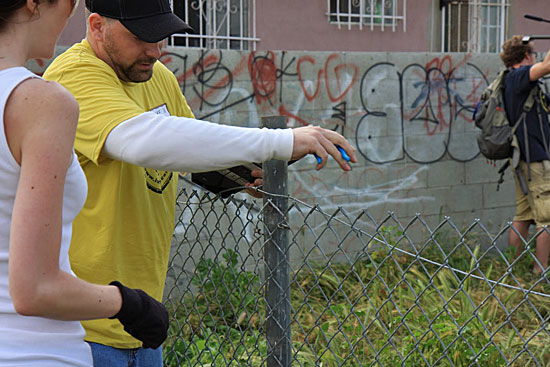
L.A. Works volunteers remove graffiti and old fencing to build a community garden for Earth Day 2011.
Posted 4/19/12
Expo wins again in court
April 18, 2012
As the first segment of the Expo Line gets ready to roll later this month, the light rail’s second leg, to Santa Monica, received an important green light this week from a state appeals court, which rejected a challenge to the project’s environmental review process.
The court found that the review was properly conducted to assess the project’s impact on future traffic and air quality. The ruling marks the second rebuff of a legal challenge to the project that was filed by the homeowners’ group Neighbors for Smart Rail. The group filed suit in 2010, but a Los Angeles Superior Court judge rejected its argument last year.
The group had contended that the Exposition Metro Line Construction Authority improperly based its environmental review on projected 2030 conditions instead of using 2009 conditions as a baseline. The group said previous court cases involving projects inSunnyvaleandMaderahad disallowed the use of such hypothetical projections.
But the appeals court said those cases did not apply to Expo.
“In our review of the record, we found the Expo Authority’s use of 2030 projections is supported by both substantial evidence and common sense,” the court said in its opinion.
The court said that it was impractical to look at current conditions in trying to assess how the project would affect traffic and air quality.
“As a major transportation infrastructure project that will not even begin to operate until 2015 at the earliest, its impact on presently existing traffic and air quality conditions will yield no practical information to decision makers or the public,” the court said. “Many people who live in neighborhoods near the proposed light rail line may wish things would stay the same, but no one can stop change.”
Terri Tippitt, president of Neighbors for Smart Rail, said that the court’s ruling is in direct conflict with decisions handed down by other state appeals courts, and her group is planning another appeal.
“The California Supreme Court needs to review and decide what the law is,” she said in a brief statement.
But Expo CEO Rick Thorpe hailed the decision. “The appellate court decision allows us to move forward without delay to this much needed project,” he said. “This is great news for improving mobility on the Westside of L.A.”
Posted 4/18/12
Free disposal day at Sunshine Canyon
April 18, 2012
If you live in the unincorporated San Fernando Valley and your garage looks like an episode of “Hoarders,” here’s a chance to dispose of bulky waste items for free. This Saturday, April 21, the Sunshine Canyon Landfill will hold a free disposal day, courtesy of Los Angeles County Supervisors Zev Yaroslavsky and Michael D. Antonovich.
To take advantage of the service, residents must live in unincorporated Sunland, Kagel Canyon, Lopez Canyon, West Chatsworth, Oat Mountain/Twin Lakes, Lake Manor or West Hills and bring proof of residency or a copy of the event flyer that was distributed by mail. Up to one ton—yes, 2,000 pounds—of household discards, including furniture, appliances and debris, will be accepted per resident.
But you don’t have to send everything to the landfill. Still useful items like functioning appliances can be donated through the Los Angeles County Materials Exchange.
Business waste and hazardous waste such as electronics, paint and cleaning products will not be accepted at this event. To find out how to properly dispose of them, visit the Department of Public Works “Clean L.A.” website or call (888) CLEANLA.
Sunshine Canyon Landfill will be open from 8 a.m. to 1 p.m. on the day of the event. The landfill is located at 14747 San Fernando Road in Sylmar. To learn about other waste services the facility provides throughout the year or to receive notification of future free disposal days, call (800) 926-0607 or email [email protected].
Posted 4/18/12
Living L.A.’s dolce vita
April 18, 2012
Los Angeles is well-established as a world leader in entertainment. But it’s also a leader in something else people can’t get enough of—leisure.
Author Lawrence Culver has traced the history of leisure in L.A. from the 19th Century to the end of the 20th Century, and he’s coming to Santa Monica Central Library for a presentation on his book, “The Frontier of Leisure,” this Sunday, April 22.
This free presentation will focus on how the importance of leisure in Southern California architecture and culture became a bellwether for the rest of the United States. With an average of 325 sunny or partly sunny days a year, that means a lot of outdoor time, and that’s reflected in the region’s backyard pools, ranch houses and resorts. A book signing will follow the discussion.
The presentation is sponsored by the Society of Architectural Historians Southern California Chapter, a nonprofit organization dedicated to sharing the architectural heritage of the region.
The event takes place from 2 p.m. to 4 p.m. in the Martin Luther King, Jr., Auditorium of the Santa Monica Central Library, 601 Santa Monica Boulevard. Seating is available on a first come, first served basis.
Posted 4/18/12
County budget hints at a turnaround
April 17, 2012
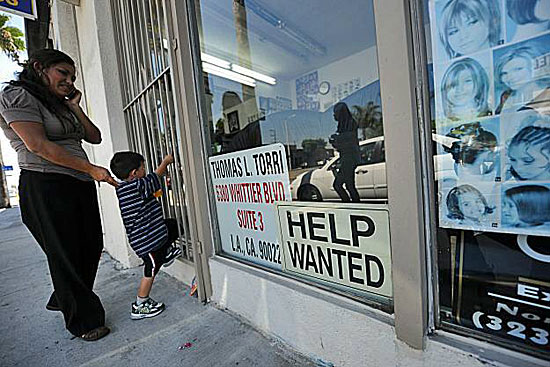
The county's new budget shows signs the economy is turning around, as hiring and other indicators pick up.
When is a $75.8 million budget deficit good news?
When it comes after three straight years of far more severe gaps that ranged as high as $491.6 million.
After several years of navigating the most profound recession in recent memory, the proposed 2012-13 county budget unveiled this week suggests that in Los Angeles County, at least, the worst may be over.
The balanced $23.78 billion budget presented to the Board of Supervisors and the public this week “will result in no layoffs, no furloughs, no service cuts and no major reduction in anything that we do,” said County Chief Executive Officer William T Fujioka.
That’s in big contrast to the dire financial plight of many other local governments in California and elsewhere in the country.
“Particularly in a county with so many needs and so many people, it’s very, very impressive,” said Supervisor Gloria Molina.
Board of Supervisors Chairman Zev Yaroslavsky joined his colleagues in praising the county’s financial position relative to others, but cautioned that a lot can happen between now and September, when the final budget will be adopted.
“I do think that we have a lot of uncertainties out there. We got a little taste of one last week when the assessor revised his estimate on property tax revenues by a significant amount,” he said, noting that other issues loom on the state and federal levels, including a Supreme Court ruling on health care reform which could have “serious and significant” consequences here.
Fujioka’s release of the proposed spending plan is just the first step in a lengthy budget process that moves next to public hearings in May.
For now, at least, there is room for cautious optimism about where the economy is heading, Fujioka said, pointing to several encouraging signs.
The caseload for general relief, which the county provides to people with no other means of support, expanded dramatically in recent years as unemployment spiked, but is now decreasing and is expected to be 6.2% smaller in the coming budget year. That’s partly because of program changes moving qualified GR recipients to federal and state assistance, but also indicates that people may be starting to find work, Fujioka said.
“It shows that people are coming off GR, that they’re going back to work, hopefully, and that the economy in general is starting to grow,” Fujioka said.
That’s significant to the budget because funding for GR comes entirely from the county and the projected savings—$27.4 million—can be used to fund other needed programs.
Sales tax revenues also are expected to tick up by 3.4% in the coming year. And state vehicle license fees, which help fund programs in county departments including probation, are rising as well, although not as robustly as Fujioka would like.
“People are buying cheap cars,” he said, jokingly telling reporters who attended his budget unveiling Monday that “I want all your readers and those who are watching on TV to go buy more expensive cars. They can help the county out.”
Property tax revenues appear to be on the upswing, too—but with County Assessor John R. Noguez’s recent downscaling of his projections, the county could be facing an unanticipated $50 million shortfall. A board-ordered audit is underway but whatever its findings, Fujioka said, “I’m confident we can manage this.”
In addition to uncertainty over property tax projections and over upcoming state and federal developments, there’s also the continued issue of the county’s sagging investment earnings, which were $201 million in 2006-07 but are expected to be just $34.7 million in the fiscal year ahead. “That has gone down dramatically,” Fujioka said. “Huge change.”
On the positive side, efficiency initiatives are expected to save the county an estimated $255 million annually. Those include finding pharmaceutical drug savings of more than $100 million a year, getting rid of unused phone lines and installing smart irrigation systems in county parks.
While it has been able to avoid laying off any employees, the county has trimmed its workforce by 2,164 positions over the past five years. Department budgets have been cut by an average of 17%. “Yet you have not seen a 17% cut in the quality or even the manner in how we deliver services,” Fujioka said.
The new budget even calls for some modest hiring, including 157 sheriff’s positions and 56 new hires in the Department of Children and Family Services. And Fujioka said the county will be able to bridge what he termed the “absolutely manageable” budget gap of $75.8 million without dipping into the county’s Economic Reserve and Rainy Day funds.
Fujioka credited the county’s overall budget situation to a stable and fiscally disciplined Board of Supervisors, to county employees who have agreed to go without raises and cost of living adjustments during tough times, and to a willingness to confront budget realities head-on.
“We do not kick the can down the street,” he said. “We deal with our problems today.”
Posted 4/17/12
New library is just Malibu’s type
April 17, 2012
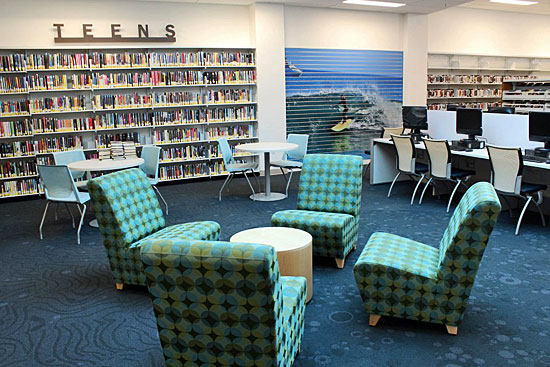
The Malibu Library, reopening this weekend, has undergone its first makeover since it was built in 1963.
It’s one thing to check out your favorite Hemingway novel. But it’s not every day that you can walk into a newly renovated library, sit down at the author’s 1947 Royal and peck out your own muscular prose.
So April 22 will be a big day in Malibu for a couple of reasons: First, the Malibu Library will be back in business after a two-year, $6-million makeover. And second, the celebration will include not only a bevy of local authors, but more than a half-dozen historic typewriters that will be available to type on in exchange for a $250 donation.
“People are going to love it,” predicts Los Angeles County Librarian Margaret Donellen Todd, who sees the library’s rebirth as a showcase for the literary and cultural roots of the famed coastal community.
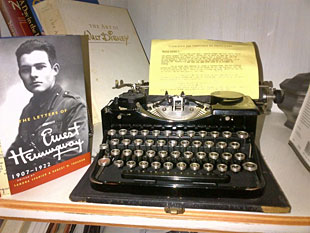
Hemingway's typewriter, along with those of other famed authors, will be on display for the library's opening.
“It’s directly across from Legacy Park, so you have that view. There’s a reading and activity garden, and glass walls that bring the outside in. The civic art is amazing—the children’s mural is beautiful, and we’ve done a tile carpet that’s a replica of the one at the Adamson House at the entry.
“There’s a teen librarian who’s going to do a lot of outreach, and there’ll be a speaker series. And we’ve gotten $25,000 to build a special collection on the surf and the ocean and sustainability.”
The renovation is the county library’s first since it was built in 1963. Spearheaded by former Malibu City Council member Sharon Barovsky, outgoing Council member Pamela Conley Ulich and Los Angeles County Supervisor Zev Yaroslavsky, it was financed with property tax revenue that had been set aside since 2004. The Malibu library is just one several recent library construction projects, including the opening of the Topanga Library in the Santa Monica Mountains.
Among other highlights, the Malibu Library includes an enlarged 100-person community room, a teen study room with floor-to-ceiling images of local surfers, a replica of a landmark lighthouse that doubles as a family restroom and indoor-outdoor spaces and skylights that bring a new sense of airiness to the nearly 50-year-old facility.
Actors Dick Van Dyke and Pierce Brosnan will be special guests at the 10 a.m. to 3 p.m. dedication, but the heart and soul of the new building will be the written—and typewritten—word.
As a kickoff exhibition, L.A. developer and civic leader Steve Soboroff offered to share his historic typewriter collection for the day of the ceremony, giving the public a one-day opportunity to try out some of the famous implements in exchange for a $250 donation that will benefit Malibu High School and the Emily Shane Foundation, a local nonprofit. On display will be typewriters that once belonged to Ray Bradbury, John Lennon, Ernest Hemingway, George Bernard Shaw, Andy Rooney, Joe DiMaggio and others.
Also available for viewing, but not for typing, will be the typewriter that once belonged to Ted Kaczynski, also known as the Unabomber.
“We think it might be offensive to some people if we were to let people type on that one,” Todd says. “It probably wouldn’t the best way to raise money, although it would be unique.”
The library also has enlisted the presence of a number of homegrown authors, including “Point Dume” author Katie Arnoldi, Delores Rivellino (“The Malibu Cookbook”), Susan Stifelman (“Parenting Without Power Struggles: Raising Joyful, Resilient Kids While Staying Cool, Calm, and Connected”) and Viki King (“How to Write a Movie in 21 Days”).
Todd says part of the renovated library’s new mission will be an enhanced speaker’s series and an area in which she plans to showcase books by locals.
“I’m really looking forward to building that out as time goes on,” Todd says. “We’re going to take our time and see what works.”
Posted 4/17/12
Freewheeling at CicLAvia
April 12, 2012
If lack of a bicycle is the only thing keeping you from CicLAvia, there’s no excuse now—you can grab one for free from Bike Nation.
A hundred bikes will be available for 90 minute reservations at the upcoming edition of CicLAvia, which takes place from 10 a.m. to 3 p.m. on Sunday, April 15th. Each person can reserve a maximum of two bikes. Helmets will not be provided, so riders are strongly encouraged to bring their own. The bikes will be located at the MacArthur Park and El Pueblo “hubs” for start times of 10 a.m., 11:30 a.m. and 1 p.m. For a full event map, click here.
Ethan Fiamingo, chief technical officer for Bike Nation, said most reservations so far have been made by people who live downtown or by public officials who don’t want to haul their own bikes or perhaps don’t have one. As of Wednesday, only 130 of about 300 available time slots were filled, but the bulk of demand is expected to come from “walk up” traffic.
Bike Nation has provided cycles for events in the past, but none of the magnitude of CicLAvia. The company approached CicLAvia organizers during preparations for the October, 2011, event, which drew tens of thousands of participants.
“Any time they shut down the streets of L.A. for something, you know it’s going to be huge,” Fiamingo said.
Bike Nation was one of several companies that participated in Metro’s “bike sharing demonstration” earlier this year (see video above). Acting on a July, 2011, motion by Metro board member Zev Yaroslavsky and others, Metro began planning for a permanent bike share program to provide short-term, automated bike rentals. Bike sharing is designed to give commuters a way to get to and from mass transit stops near their homes and workplaces, as well as provide a healthy alternative to short car trips for errands. Similar systems are already in place in Denver, Paris and Washington D.C.
“We have been working with the city and organizations like Metro for the past two years to bring bike sharing to L.A.,” said Derek Fretheim, Bike Nation’s chief operating officer. “CicLAvia seemed to be a worthwhile event to increase bicycling awareness and bicycle behavior.”
Other than Bike Nation, there are a few other options to get wheels in time for CicLAvia. Downtown L.A. Bicycles, DTLA Bikes and Flying Pigeon L.A. are offering paid rentals.
Posted 4/12/12
Little parks, big impact
April 12, 2012

This artist's rendering shows how a new park next to a Hollywood Freeway off-ramp will look when completed.
Four of Los Angeles’ newest planned parks could fit comfortably into a tiny fraction of Griffith Park’s sprawling 4,210 acres.
But the new parks, ranging in size from ¾ of an acre to 2.8 acres, have grand, out-of-the-box ambitions of their own—and each could play a transformative role in the aesthetics, health and recreation of their communities.
The parks will be funded by $5 million in state grants recently awarded to the Mountains Recreation Conservation Authority, which will work with community groups to develop the new recreational expanses in Hollywood and Pacoima—both in the 3rd Supervisorial District—as well as in Elysian Park and Compton.
All of the parks promise to bring small-scale pleasures, along with forward-looking environmental features, to areas hungry for a little green space.
“I think that L.A. is just a concrete jungle. The parks are large and they’re far away. People have to drive to get to Griffith Park,” said landscape architect Jeff Hutchins, a principal in Mia Lehrer + Associates, which is working on the ¾-acre Hollywood project. “People don’t necessarily need basketball courts or running tracks. People just need someplace close by to sit and reflect and spend some time with their family.”
The Franklin/Ivar Park, to be created on a triangular parcel below the Vine Street off-ramp of the Hollywood Freeway, represents the power of consistent neighborhood involvement in getting such projects off the ground.
“We have absolutely zero green space in this neighborhood,” said Terri Gerger, who’s heading up the initiative for the Hollywood Dell Civic Association, a longtime backer of the project. “There is no park space for kids.”
The lot, originally acquired by Caltrans when the 101 Freeway was built, has been vacant since the 1950s. George Abrahams, an adopt-a-freeway volunteer who lives in nearby Beachwood Canyon, has devoted untold hours to clearing the property of debris and keeping its exuberant bougainvillea in check over the years.
Going through the lot, where homeless people and drug users once congregated, “was like an archaeological dig,” he said. “I pulled about five or six thousand needles out of that area.”
At the urging of the community, the Santa Monica Mountains Conservancy purchased the property from Caltrans for $162,100 in 2008, with a significant contribution from the developer NCA/Commonfund, help from private donations and funding from state Prop. 84.
Now the grant from the conservancy’s partner agency, the Mountains Recreation Conservation Authority, will deliver $2 million to transform the Franklin/Ivar site. Plans call for a “carbon eater tree screen” to help absorb and filter polluted air coming off the freeway ramp, a water reclamation feature, a solar-gathering shade area, a water fountain, a demonstration garden, an “adventure play area” for kids, public art, and even an amphitheatre and grotto. And there’ll be Wi-Fi—an important attraction, Gerger says, for students at nearby trade and technical schools who are expected to use the park along with local residents.
In Pacoima, the impetus for creating a park on another once-forsaken piece of land is part of the movement to create healthier communities by carving out appealing places for outdoor activity.
The Pacoima Wash Greenway-El Dorado Park project grew out of an earlier county Public Health PLACE grant to Pacoima Beautiful, which is seeking to improve the health of a community that experiences high rates of heart disease, stroke, asthma, diabetes and obesity—all consequences of a sedentary lifestyle in an area where recreational amenities are few. Nearby industrial plants contribute to poor air quality, and some children suffer from what the grant application describes as “Nature Deficit Disorder.”
While the planned park itself occupies just 1.2 acres, it’s part of a larger initiative that’s eventually expected to create a publicly accessible greenway all along the Pacoima Wash and link it to larger recreational areas like the Angeles National Forest to the north and Ritchie Valens Park to the south.
“It’s the connections that are important,” said Ken Frederick, project manager for Pacoima Beautiful.
The city-owned property will benefit from $1.075 million in grant funding to plant trees, develop a free play area in a natural grass meadow, build a trail loop and create a “stormwater arroyo” that will allow plants to naturally remove contaminants from water as it flows into the ground.
The other grant recipients are the Los Angeles River Marsh Park in Elysian Park, which is receiving $725,000 to add an open air picnic area and community gathering spaces to the 2.8 acre project, and the Compton Creek Natural Park at Washington Elementary School, which will get $1.036 million to bring children’s recreational amenities and learning gardens to 1.3 acres of vacant school property.
With their environmentally-friendly features, educational components and public health roles, the new parks promise to be a hard-working bunch.
“A park can’t just be a patch of grass and a baseball field anymore,” said Eric Bruins, a Mountains Recreation Conservation Authority projects manager who’s overseeing the Pacoima and Hollywood parks for the agency. “It has to do many more things.”
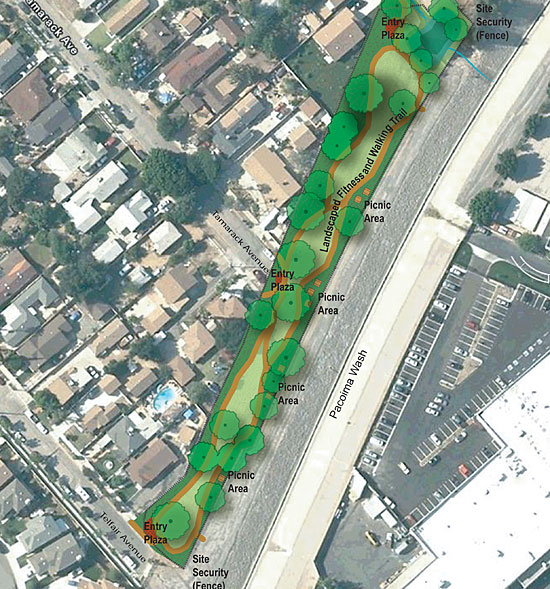
This illustration gives a sense of the green space that's about to sprout up along the Pacoima Wash.
Posted 4/12/12




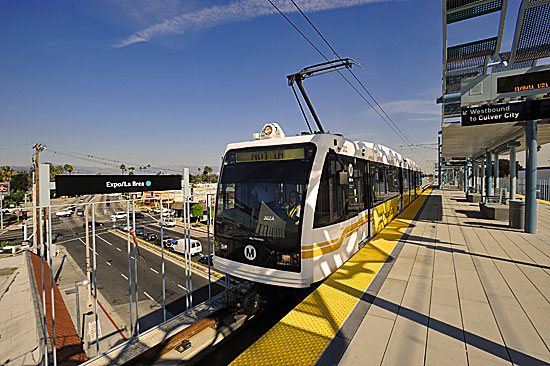
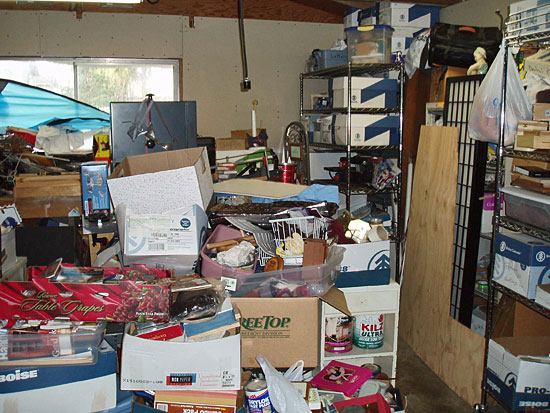
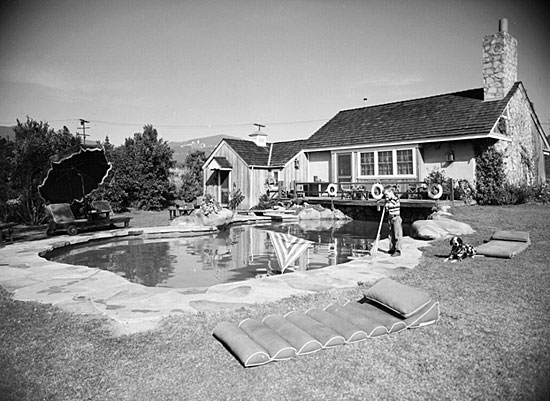
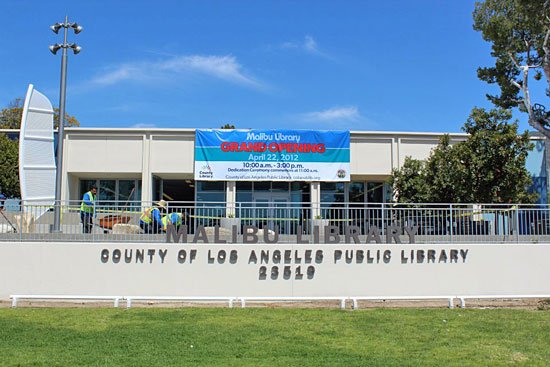
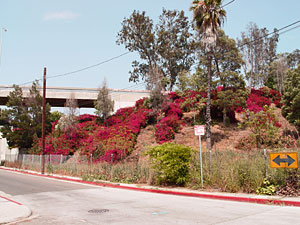





 Check for the latest closure information
Check for the latest closure information








